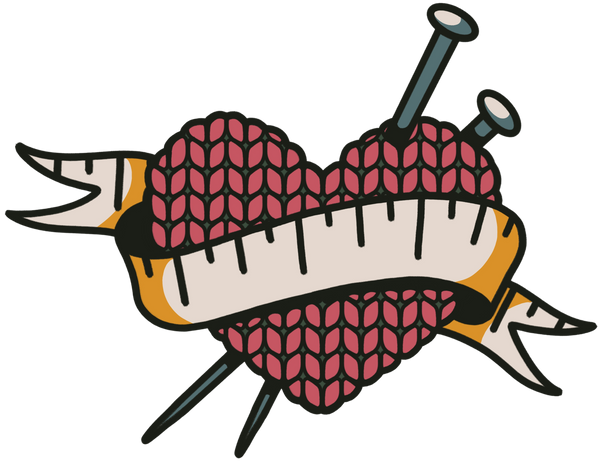Guide to Size-Inclusive Knitting Patterns

Size inclusion in knitting
Over the years, we've shared our thoughts about size inclusion in articles, speaking engagements, and classes. Now, we're sharing it here.
Below, you'll find our complete guide to size-inclusive knitting patterns. Whether you're a designer, maker, publisher, yarn store owner, or content creator - we think there's something here for everyone!
What is size inclusion in knitting patterns?
Size inclusion is a justice movement
Size inclusion is the practice of ensuring that knitters at all sizes are fully included in our knitting community.
In practice, this means that all knitters have equal access to patterns in their size (and that those patterns fit well), they can buy enough yarn in a dye lot for their sweaters, and that their work is celebrated, shared, and spotlighted equally.
Consistent with the treatment of larger (and very small) bodies in the rest of our cultural spaces, the knitting industry has historically poorly served all but a few sizes. That means many knitters struggle to find patterns that fit them.
With the rise in vocal demand for size-inclusive patterns, we’ve also seen an uptick in the number of patterns that include larger and smaller sizes, but are so riddled with fit issues in those sizes that they create garments that either can’t be worn or are no longer the same pattern.
In many ways, this is worse than not having the size at all. As frustrating as it is to see that a pattern doesn’t include your size, it’s even more frustrating to invest money in a pattern and time in making a garment, only to find that the end result is a total waste.
We've come a long way
When we (Jen and Bess) started knitting at the turn of the century, patterns included four or five sizes, and had finished measurements around 32 - 42”. That meant they were usually intended to fit someone with a full bust of approximately 30 - 40". Occasionally we’d see patterns with finished measurements up to 48".
In the last few years (especially since 2019), we’ve seen a lot of change.
Knitters are searching for size-inclusive patterns, and we are beginning to have a shared definition of what “size-inclusive” is (more on that later). We also have much more savvy knitters, who are more likely to understand industry terminology, like “grading,” and who are able to detect fit issues before purchasing a pattern.
With the market jam-packed with beautiful sweaters, knitters are increasingly able to choose patterns from designers who share their values, including a commitment to size inclusion. All of this means that knitters have been the ones to drive industry change over the last several years.
As a result of that use of purchasing power and social pressure, we now see many more sweaters that include a range of sizes designed to fit adults with full busts as small as 28” or as large as 70”.

The state of the knitting size-inclusion movement
Here at One Wild we are committed to size-inclusive patterns and business practices and we tend to surround ourselves with makers and peers who share those values.
That means that we operate in a bit of a bubble - it’s easy to start to feel like “okay, everywhere I look I see size-inclusive patterns, so we’ve done it!”
But if we look past the bubble of our peers and the makers in our lives, is that the lived experience of most makers?
We like to check in and see how things are outside of our bubble. Periodically, we conduct a very informal size inclusion snapshot. That means that we get curious and head over to Ravelry to see what’s happening on “hot right now.” Our snapshot is designed to answer a simple question: “if I’m a maker who wants to browse and choose a pattern, to what extent will I feel that bodies like mine are welcome and included in this community?”
Although Ravelry is an imperfect resource (and many users have challenges with the site for other accessibility reasons), Ravelry still has tremendous power in the marketplace. At the time of this writing there’s no other clearinghouse like it and at over a million patterns, no other site is a close contender. “Hot Right Now” (HRN) is the view a maker will see if they navigate to Ravelry’s pattern database, so someone who hops on and starts browsing will encounter that sort first.
The snapshot is a very quick analysis. We look at the finished bust measurements of the top 25 garment patterns and run the numbers to see who can wear them with the designer’s recommended ease. We usually end up conducting a Snapshot roughly twice per year, just to keep an eye on things.
The July 2024 Size Inclusion Snapshot
We conducted our most recent Snapshot this July (specifically, on July 9th, 2024).
Some of the key takeaways were:
- Of 25 patterns, only two had a size-inclusive range (for bodies with full busts 30 - 60"), one from Lydia Morrow and one from Audrey Borrego
- Seven more patterns were partially inclusive: they offered either enough small sizes or enough large sizes
- Fifteen patterns did not offer enough small OR large sizes
- The average smallest size available was for someone with a 33" full bust
- The average largest size available was for someone with a 56.5" full bust
Note: Did you notice we emphasize the very smallest sizes as much as the very largest sizes? All means all, and the smallest bust sizes have historically been excluded as regularly as larger sizes.
We recognize that makers with smaller bodies often encounter marginalization in our broader society, and that many people who would never comment on a larger body feel free to make disrespectful comments about small bodies.
We also recognize that people in larger bodies often face more extreme harm because of their marginalization.
We make no attempt to prioritize either experience, because skilled grading and design addresses the needs of both populations of makers.
The Snapshot has major limitations and should be viewed as an anecdote. HRN is subject to change from minute-to-minute and a new release from a big designer can dramatically skew the results (and in fact, looking at the data table at the end of the Snapshot will show that this is the case in July).
Even with that limitation in mind, over the last few years we've seen that change is very gradual. In the Snapshots we've conducted, we have never seen as many as half of the patterns offer a size range we consider size-inclusive.
We're sharing our Snapshot
We’ve never published one of our Snapshots before, but we are today. If you’d like to read about the methodology and see the patterns we evaluated, share your email address and we will send you a copy!
Sharing your address will sign you up for our newsletters, but if you want to unsubscribe once you’ve got your report, we won’t mind!
What responsibility do third-party sales platforms have for creating change?
As we outline in the report, HRN has a self-perpetuating effect. Once a pattern has a lot of visits, it appears in HRN, and the increased visibility leads to more visits. HRN does not measure pattern quality, maker satisfaction, number of actual purchases, projects or percentage of projects completed. It simply measures traffic.
Which leads us to ask - what responsibility does Ravelry play in shaping what we expect from patterns, and what responsibility does Ravelry have to its customers?
We argue that a values-based company should make sure that its customers have an inclusive experience. The default view should prioritize size-inclusive patterns. Makers should have to dig a little for patterns that exclude.
We also argue that because ranking high can drive pattern sales, ranking high should only be possible for patterns that include all members of our community. Ravelry’s June 2024 traffic from Google was over one million visits. Because the potential upside for a pattern seller appearing on the first page of HRN is very high, Ravelry has the power to use their platform to shape behavior by creating a financial incentive for good behavior.

What does it mean to be size-inclusive?
In our Snapshot, we apply a very rough metric to answer a limited-scope question: will a maker feel included within the size range of a pattern?
But being inclusive is a practice, not a checkbox.
Yes, the first step for pattern-sellers is to offer a full range of sizes, patterns need to do more, designers need to do more, and there are critical roles for all members of our industry and community.
Size-inclusive patterns
If a full range of sizes isn’t enough, what else does a pattern need to do?
While there’s no authority that certifies patterns, we know what we look for when someone asks us to recommend a pattern. No single set of criteria can remove the responsibility we feel when we answer these types of questions, but we do start by running through some checks.
Does the pattern include, at a minimum, full busts 30” to 60”?
Generally, patterns are graded every 4”.
What is “graded?” Grading is the process of taking a pattern in a single size and turning it into a multi-sized pattern. When we say a pattern is graded every 4", that means each size is 4” larger than the last size.
Typically, we see patterns graded to fit full busts in one of two size series:
- Full bust: 28, 32, 36, 40, 44, 48, 52, 56, 60, 64, 68", or
- Full bust: 30, 34, 38, 42, 46, 50, 54, 58, 62, 66"
There are many reasons that a designer might choose one series over the other, but typically a designer chooses the range that includes a size that fits them well. For example, Jen typically grades for sizes 28 - 68" because she has a 44" bust. She would be between sizes on the other series, and it would be more difficult for makers to visualize the intended fit.
We love it when a pattern includes 28” and sizes above 60”, but we recognize that size charts that include those measurements have been expensive and hard to find. However, designers have had access to high-quality free charts that cover 30 - 60” for many years, so that’s what we’re looking for.
Note, this is the only measurement that our Snapshot looks at, but it’s not the only measurement that matters. For more info on why we use this measurement for analysis, download the Snapshot and review the Methodology.
Are you a designer looking for a size chart that includes an expanded range of measurements that includes the measurements you need to include bust darts? You can join us in grading for sizes 28 - 68" by adding your email below, and we’ll email you the link!
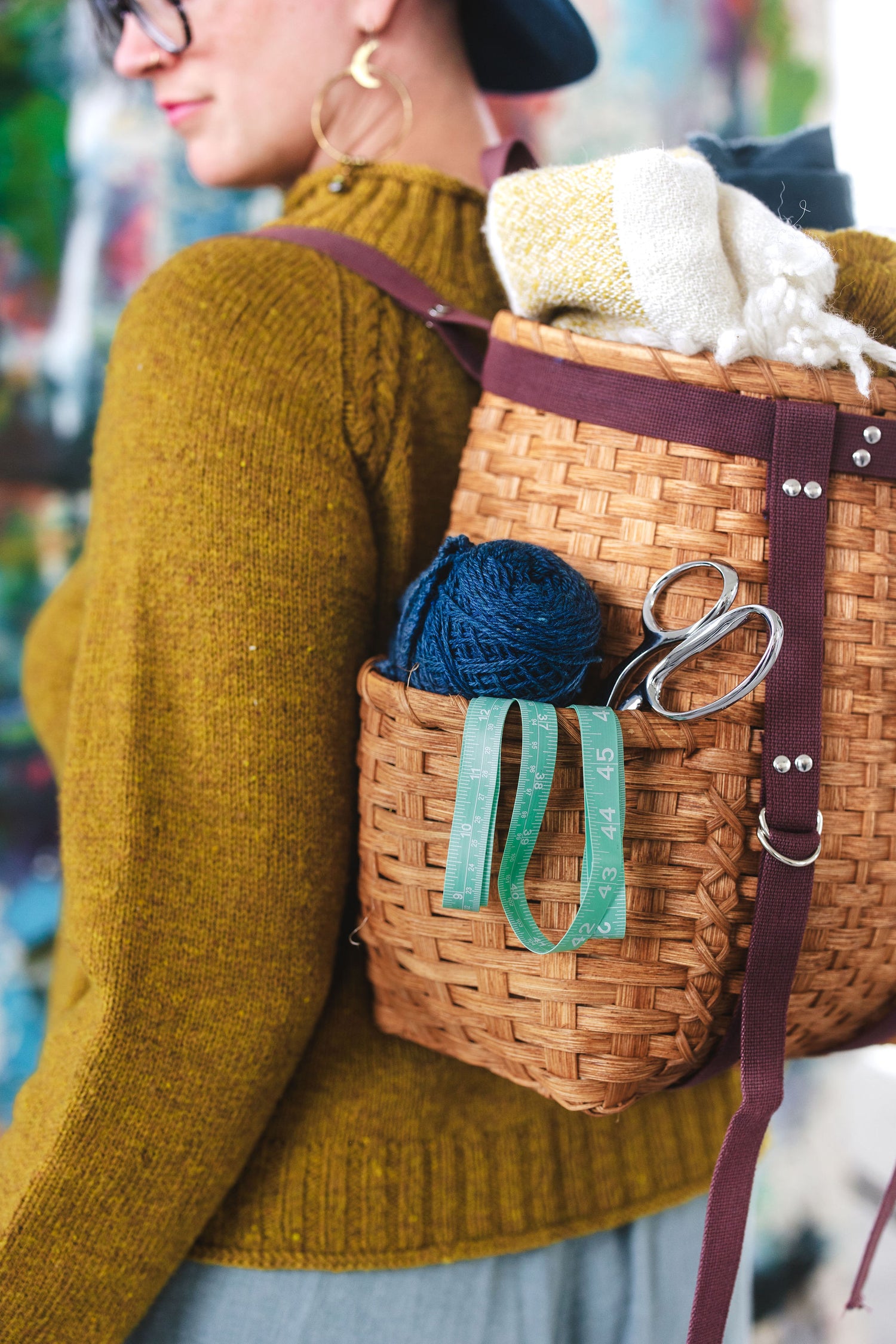
Does everyone have equal access to a good fit?
If the smallest sizes are 2" apart and the largest sizes are 4" apart, we generally don’t consider that a size-inclusive garment.
Having sizes 4" apart is the standard, but sometimes a designer will choose a 2" increment instead.
But if some sizes have access to half-sizes and others don’t, that is not equal access.
Exceptions?
Sometimes a large stitch repeat will work out so that there are fewer sizes thoughout the range. That happens when the target stitch counts for two sizes are rounded to the nearest stitch repeat increment and the same number of stitches results.
In that case, we would expect to see those ‘gaps’ in sizes throughout the range, not simply more sizes in the bottom half of the range than the top.
We also sometimes see impossibilities in putting large bust dart cups into small garments. Bust darts are worked with short rows, so each row needs its own stitch to turn. We offer bust darts in multiple cup sizes and try to add up to 5” of additional length for the largest cup. Sometimes it works out that there are not enough stitches for the smallest garment sizes to work the largest cup size, simply because there are not enough stitches to make that turn.
Quality matters - how do the extended sizes fit?
Throwing together poorly designed extended sizes simply to check a box is not inclusive. In order for a pattern to be size-inclusive, it has to not only have a complete range of sizes, but it has to create the same garment for each size. That means the fit is consistent for every size and all sizes look like they are the same garment. That can mean dramatically different instructions for each size in order to accomplish the same thing.
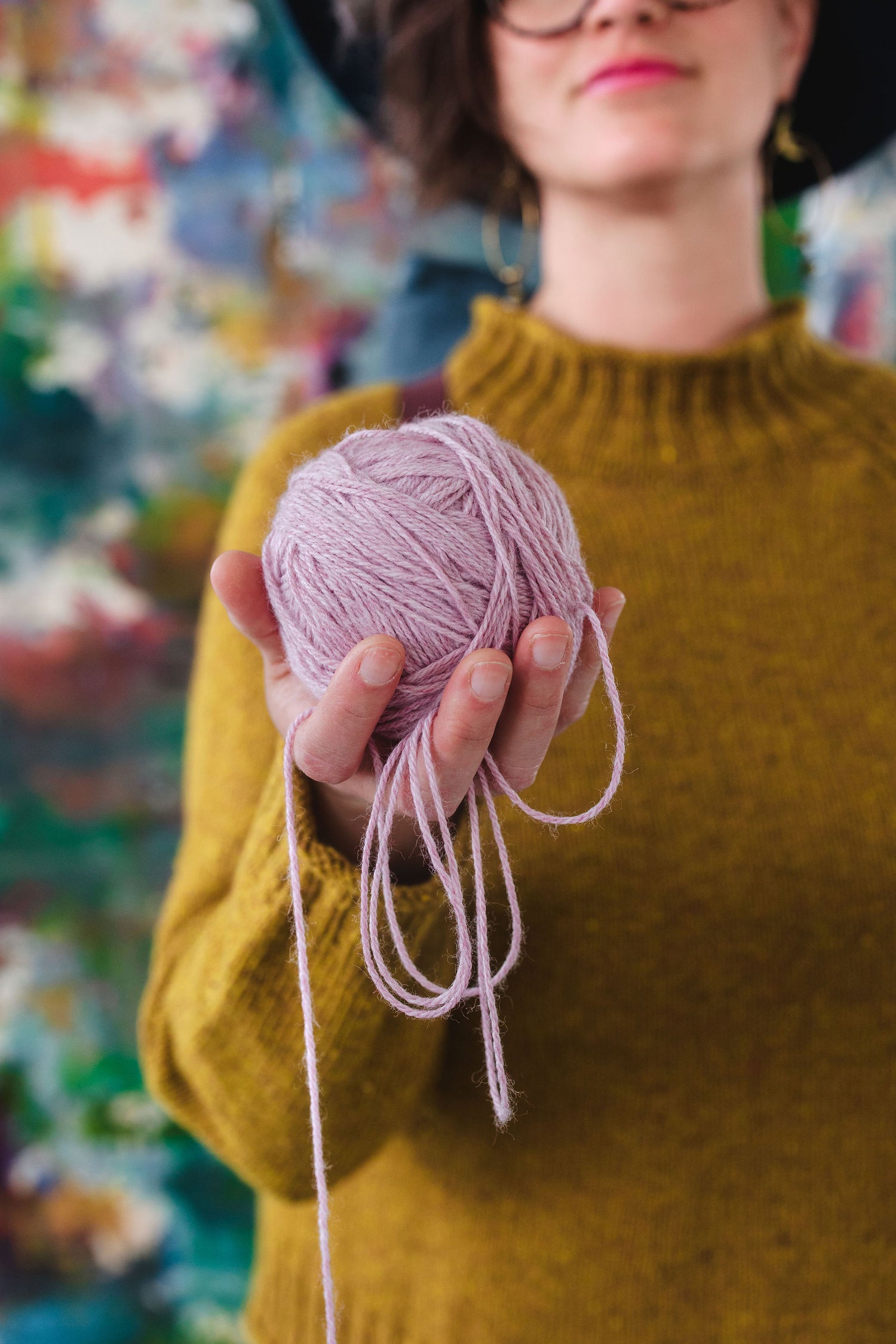
Patterns that are designed to include people of all sizes should:
- Include clear and complete schematics that help makers identify all the critical fit points
- Provide the complete schematic before purchase
- Have helpful guidance for choosing a size, identifying when a maker may want to size up
- Include notes on where the garment’s hem is intended to land, so that makers can adjust the length as necessary
What about knitters with different shapes?
We talk about size inclusion a lot - making sure that a person of the same height but of different sizes can make the same pattern. But what about makers that are not the same height, or have a different bust/waist/hip ratio? What about makers who fall into a size 3 on the top and a size 6 on the bottom?
We differentiate between size and shape inclusion. While a pattern may be size-inclusive, that doesn’t necessarily mean it’s “shape-inclusive.” For a pattern to be shape inclusive, it would need to have separate sets of instructions for each full bust size in several different heights, have different body shaping to accommodate different hip shapes, and need several sleeve options for different upper arms…
Our opinion is that everyone will need to make at least some adjustment to a pattern in order to get a truly bespoke fit. Even though it's not possible to create a fully-graded pattern for every combination of measurements, there are some things designers can do to help makers achieve success.
We find that makers in larger bodies especially benefit from this extra support, and may disproportionately have been excluded from ever finding a great fit. Patterns that include some shape-inclusion measures can help more makers close the gap between that they've experienced and what's possible.
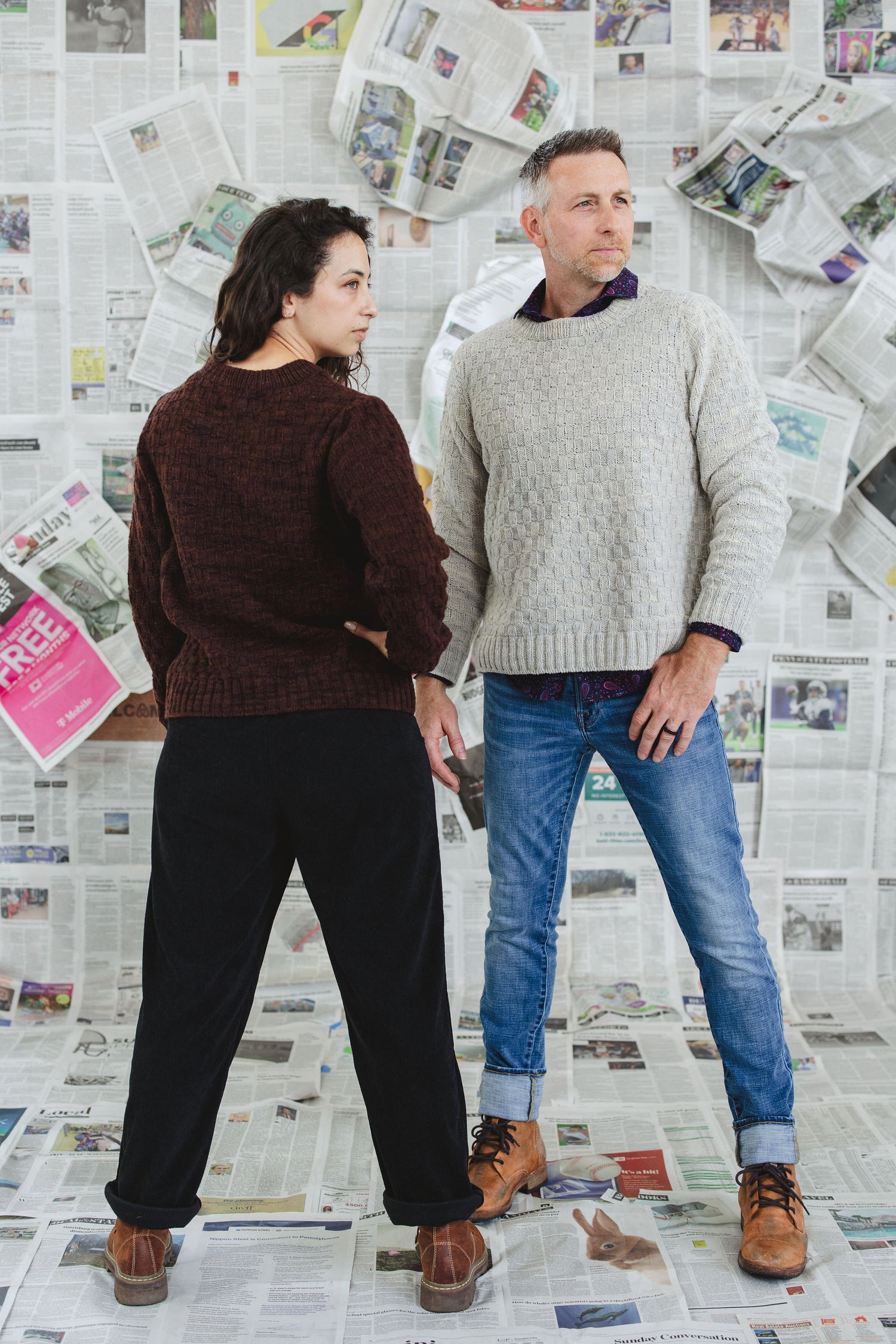
To reach more makers, designers can also:
- Provide information on extra yardage required to add length to cropped sweaters
- Include optional hip shaping guidance when it might be helpful
- Include optional bust darts in multiple cup sizes
- Provide a second sleeve fit option if the sleeve is intended to have a close fit
We also encourage makers to find designers whose work tends to fit them well.
Generally, designers use the same size chart for every pattern. They might make modest tweaks as they evolve and gather feedback from their audience, but in general? What you get once is what you’ll get again. If you make a sweater from one designer and the sleeve is too tight, you can expect the same from their other patterns.
Designers customize their size charts for their intended knitter (for example, we know that more mature knitters are drawn to our patterns, and we lowered the bust apex in many of the sizes to accommodate a more mature bustline location). Take advantage of this by experimenting until you find a designer that understands your needs!
What about formula/spreadsheet patterns?
Doesn't ALL mean ALL? If we continue to dig further into size and shape inclusion, we run into what we call “formula patterns.” Designers and makers who love these patterns feel that "the only truly size-inclusive garment is the one that adjusts to fit your body no matter what your measurements are!"
Our definition of formula patterns includes:
- Patterns that generate a finished pattern based on measurements you put in, and/or;
- Patterns that come with a spreadsheet or formula page where you calculate your own measurements and put them into blanks in the pattern.
We’ve investigated a few of these, using our own measurements as examples. We also talked to makers who made garments (and had good or bad experiences) with these patterns. Jen has also worked 1:1 with knitting clients who have purchased such patterns and found that they yielded impossible results, such as “work -8 rows in pattern as established.”
When we talk to makers who love formula patterns and who get the most benefit from using them, we find they are makers who are already savvy at modifying patterns and understand their fit needs. They expect they’ll need to adjust the formula pattern once it’s generated, but it’s still less work than it would be for them to alter a standard pattern. Basically, they’re starting closer to the finish line then they would be with a fully-graded pattern.
We purchased and evaluated a few highly-rated formula patterns and we found that for our measurements, we would need to make several modifications to achieve the fit we prefer in our garments (such as adding shoulder shaping). We also found that these patterns did not account for the relationship between bust size and torso size, and consistently created garments that fit at the bust and were too wide at the shoulder.
Designers do use formulas to create their patterns by starting with a set of measurements in a size chart. It's intuitive to think that by substituting the size chart measurements with a real person's measurements and applying the same set of formulas, we could offer an adjustable pattern.
However, different size blocks might use slightly different formulas, and we often use our subjective experience to override what the formulas tell us.
To zoom out, both fully graded patterns and spreadsheet patterns will serve different knitters in different ways. We all have different priorities when we make our clothes. There is no wrong way to love knitting and it's a good thing for our community to have lots of different types of patterns available.
If you think you might like to try one of these patterns, buy one! You can put in your dimensions and see what comes out and decide if you’d like to knit it. Formula patterns are priced like other patterns, so you don’t have much at risk if you decide to go for it.
If you'd like to go deeper into this topic, we talked extensively about formula patterns in Episode 15 of our broadcast.
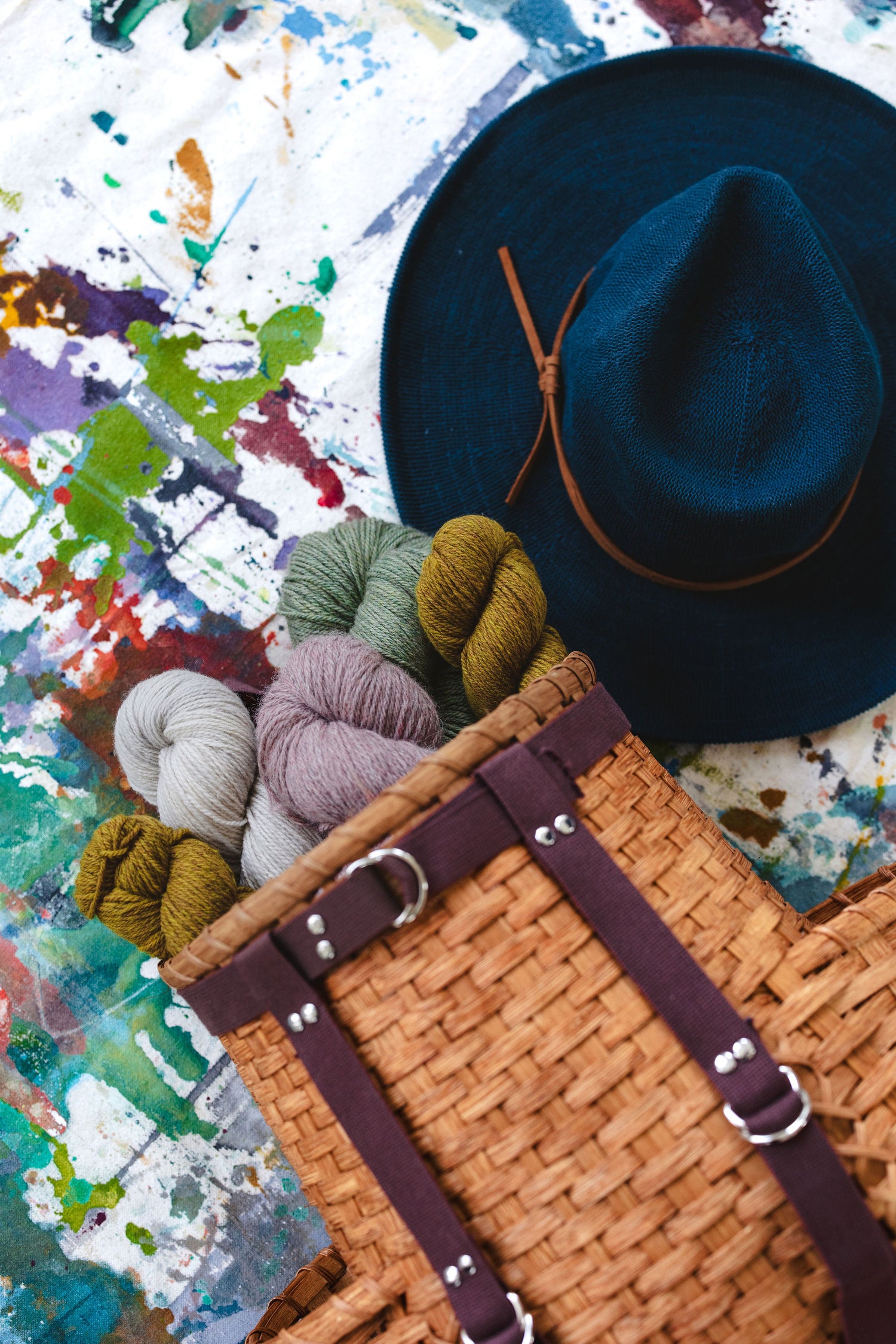
Special considerations for designing size-inclusive patterns
At its core, grading for a larger range of patterns is no different than grading for a limited range. You reproduce the fit of the sample at each key fit point for each size - done.
But to do that well, designers need to know a lot about fit.
If a designer has holes in their fit knowledge, those holes might not be as obvious if the garment comes in a limited range. Some sizes might not fit quite as well as the sample size, but maybe it’s not enough to irritate the maker. But when those problems are magnified across the range, things start to fall apart.
Ensure your size-inclusive knitting pattern addresses these grading concerns
Consider the weight of the garment
As garments get larger, they get heavier. They will stretch longer in the body, and the sleeves will pull laterally on the neckline. Designers should consider:
- Qualities of the yarn - is it slippery or grippy?
- Construction of the garment and it’s inherent structure - is it seamed or not seamed? Does it have cables or add structure in other ways?
- Ease and silhouette - does it have tons of positive ease and flow from the shoulders? Or is it cropped with negative ease? and;
- Grading choices - do we need to use a second, weighted gauge for the parts of this garment that hang? Do we adjust the neck depth and width to account for the impact of the garment’s weight?
The total combination of these decisions must add up to a garment that fits, behaves, and looks the same in each size, even if that means applying different rules to different sizes.
The old “ratios” don’t work
Many of us grew up creating garments that followed ratios, and some still frequently-referenced knitwear design books recommend these ratios. The upper arm circumference should be X percentage of the full bust, for example, or drop-shoulder garments that are basically rectangles - knit the body, split it in half, add sleeves, done.
Ratios work fine for a handful of sizes in the middle of the size range, but the method doesn't work when we expand our size range.
Instead, designers need to examine where key construction elements will fall and what is needed for the garment to fit well for all sizes while still creating something visually consistent.
In our example of a drop-shoulder garment, following the basic formula for a drop-shoulder results in a sweater that has the shoulder seam way too high on the shoulder in the smallest sizes (they won’t be able to move their arm without tearing the garment). In contrast, the largest sizes may find the shoulder seam way down near their elbow, with oodles of fabric pooling under the arm.
The appropriate way to address this is to grade the width of the garment at the shoulder using the cross-shoulder width of the body, and to add shaping between the underarm and the shoulder to arrive at the desired width.
That may mean that the cross shoulder has more OR fewer stitches than the front and back at the underarm.
Schematic first, shaping second
Many new designers have knit dozens of raglan sweaters and find them intuitive and easy to make so they pick a raglan for their first design. They run into their first problem fast: if they follow the familiar instruction to “increase 8 stitches every other round until you split for the sleeves and body”, the final product does not create consistent ease in the upper arm, the bust, or the underarm depth.
Instead, designers must identify the key fit points and grade them individually. The shaping instructions are always in service of the desired final measurements and figuring them out comes after determining the stitch counts and rows that make up the schematic.
Keep an eye on total lengths
A size chart holds a knitter's height to be fixed, no matter their size. That means that in general, we don’t expect total lengths to change much.
It’s fairly typical for the total body length (and sometimes the total sleeve length) to get a little tiny bit longer with each size. That’s because as we get larger, we get curvier, and the lengths in our size chart are vertical depths, not the length a tape measure would travel if it were laid down on the circumference of a curve.
A standard expectation is that on a 4” grade, each size’s total body length would get .25” longer. If sleeves are very close to the arm, the sleeves might also get longer, but if there is positive ease in the upper arm then they probably don't need additional length.
This breaks down when designers use a consistent underarm to hem or underarm to cuff length to create their body and sleeve measurements. Or worse, when those measurements get longer as the sizes get bigger.
As the body gets larger, our underarm area gets bigger and fills in with tissue. The size chart will include an increasing underarm depth that reflects this reality.
We see designers create increasingly deep sleeve caps and underarm depths to create this needed room - good! But then we see them tack on the same length for each size between the underarm and the cuff, and the underarm and the hem.
On our chart, the underarm depth changes 3.5" between the smallest and largest sizes, but the arm length is the same for each person. If my middle size hits right at the wrist and every size works 18” from the underarm to the cuff, then the smallest size will end 1.75" above the wrist, and the largest size will end up 1.75” below the wrist.
To have appropriate lengths, we need to start with the desired total length and subtract out the underarm depth (for the body length) and the cap height (for the sleeve length).
Grade on the correct measurements
The final fit topic we want to cover is choosing which body measurements to associate with which garment measurements. This means knowing what drives fit at each point, and choosing wisely how to grade for it. Let’s do two examples.
Earlier we talked about drop shoulders, and how the old way of creating them resulted in a garment cross-shoulder width that was driven by bust width (always ½ of full bust garment full bust, and garment full bust is body full bust plus ease).
Instead, the garment cross-shoulder width should be based on the body’s cross-shoulder width.
Another common problem we see is neck depths that vary between the smallest and largest sizes. Our necks change some as we get bigger, but not very much Furthermore, it’s very rare that a sweater’s neckline lands exactly where the body and neck connect.
It’s visual distance here that matters, not the neck’s size.
Just like we want every sweater to be the same length visually, we also want the neck depth to be the same visually. Generally, if a neckline is crew neck or deeper, we would not expect to see a change in neck depth across the size range.
Choose the right approach to scaling design features
Similarly, we run into questions like “where do I place this motif?” Sometimes, we’re asked things like “shouldn’t my motif contain more stitches as the sizes get larger?”
Generally, we recommend approaching motifs and special elements in one of two ways.
Consider white space balance
If a design contains a big, single, important element, consider the ratio of white space to active space.
For example, if I were putting an intarsia heart in the middle of my sweater, a 3” heart would not look the same in my smallest and largest sizes. I might grade an element like that by tying the motif’s width to what percentage of the front width it covered, and create a handful of different chart options for makers.
We often use this approach for patch pockets too. A pocket probably doesn’t NEED to get bigger, but if it’s a design element, the same pocket might dominate a smaller sweater and be lost on a big sweater. In this case, we’d create 3 - 5 pocket sizes.
Finally, consider placement. For motifs on the body, we often tie these to apex width.
As we get bigger we get rounder, so more of our circumference is on the side of the body. Tying the location of a motif to the bust apex means that we’re always looking at the part of the body that will read as “front.”
Pretend you’re going to the fabric store and buying materials
When we’re working with stitch textures and elements that divide the space into pieces, we often treat these elements as if we were going to the fabric store and choosing trim or a fabric with a print. No matter what size shirt I’m making, the hearts printed on this fabric are 1.5” wide. We always follow this rule with all-over stitch textures.
What about a single cable that runs up and down the width of the garment? These types of elements typically contribute to a design by identifying a focal point, or visually dividing the garment to create rhythm or symmetry. In these cases, it’s not the motif itself that’s important. It’s how it moves the eye around the garment.
For elements like these, imagine you’re buying trim or braid to adorn a shirt you’re making. The placement might be graded, but you’re always going to be using the same trim no matter what size you make.

"Being" a size-inclusive designer
“Being size-inclusive” doesn’t end with creating a pattern. Who we are is more than just one thing that we do, right? Running a size-inclusive design business means lots of other behaviors!
If you're a designer, what other practices do you have in place to support makers of all sizes? Here are some things we consider best practice:
- Run tests or user experience projects that have plenty of time for makers of all sizes to finish
- Share and celebrate the work of makers of all sizes
- Consider your line of accessories. Will a 6” wide scarf look the same on everyone? Will a poncho cover their bodies equally? Size inclusion is not just for garments!
- Offer sizing guidance that helps knitters navigate the best fit possible
- Work with yarn stores and yarn companies that offer large enough dye lots and in-stock yarn that all makers can purchase the full quantity for your project
- Hire tech editors and graders that have demonstrated knowledge of fit
Size inclusion requires all of us
Designers have an important role to play in creating a more size-inclusive community and industry, but they’re by far not the only players - and maybe not the most important ones!
We already talked about the role that 3rd sales platforms like Ravelry could play if they took responsibility for the power they hold, but what about the rest of us?
If you’re a dyer, are you offering sweater quantities for all sizes equally? Or do you generally list six skeins in your shop update with a note that if someone needs eight they can send you an email to set up a special order?
If you sell yarn in person, are your aisles big enough to shop comfortably for people of all sizes? Do you stock sweater quantities for all makers?
If you’re a publisher that outsources pattern writing, are you allocating enough pages in your publication for size-inclusive designs? How are you assessing the quality of the fit in the largest and smallest sizes when you receive patterns from designers?
If you’re a maker, do you buy patterns from size-inclusive designers?
If you’re a social media user, have you curated your stream to make sure that you’re seeing makers in larger and smaller bodies? Makers in larger bodies are often not as well-celebrated, and so algorithms hide their work. How do you counteract the bias built into the software? Do you have a plan for sharing and celebrating size-inclusive projects as much as you share and celebrate the work of straight-sized makers?
If you create content, how often are you centering the voices and experiences of makers in the largest and smallest sizes?
If you hold events, how big are your chairs? Do they have arms?
We have lots of ideas about how we can all move the community in a more inclusive direction - if you’d like to read more, you can visit this article that lists 45 actions to support the size inclusive movement.
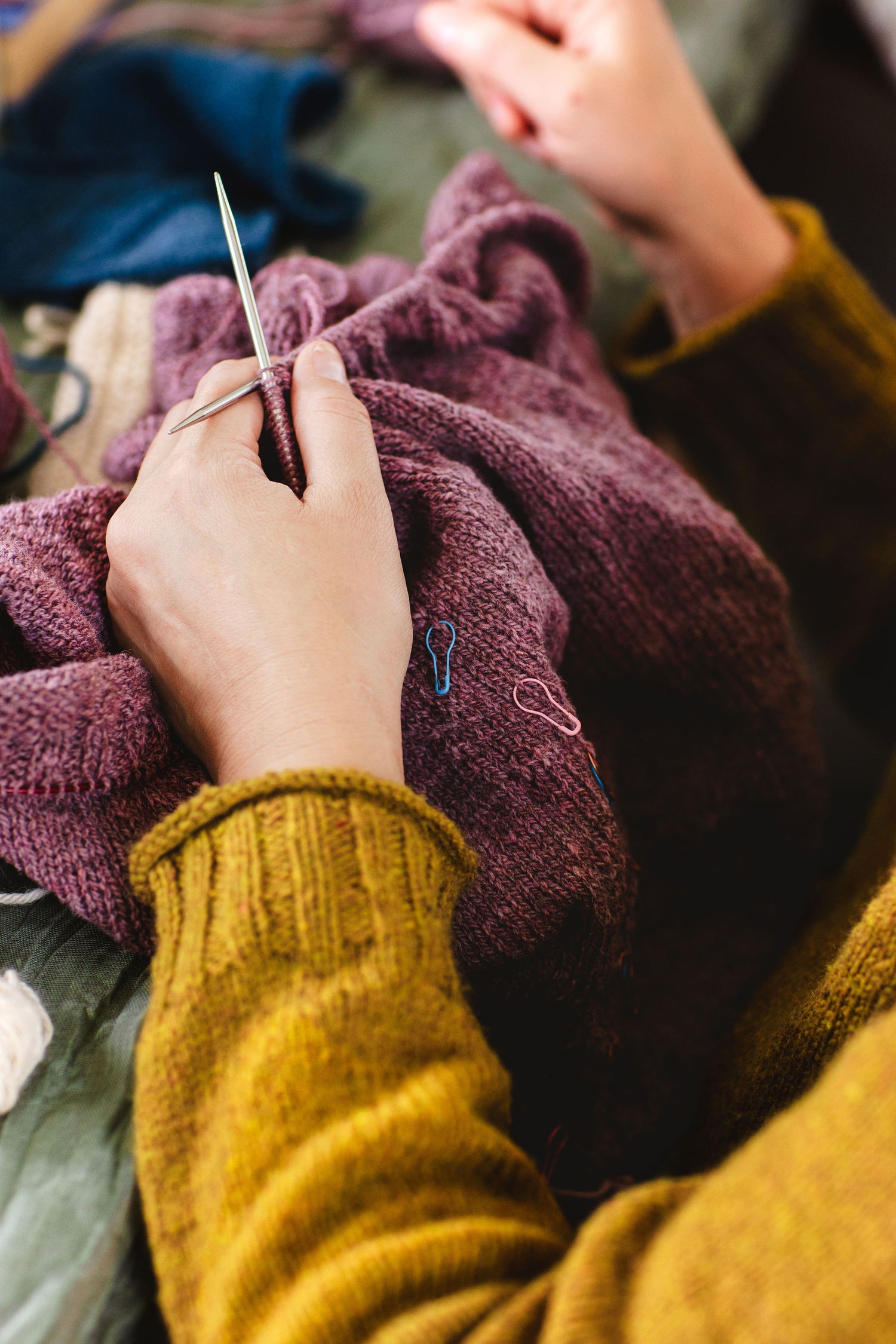
Assessing patterns
Maybe you want to vote with your dollar for a more size-inclusive future, or maybe you wear a size that sometimes is not included. How can you look at a pattern and tell whether it’s really size inclusive?
Start with looking at a pool of patterns with a size-inclusive range
One very popular resource, generously provided by Autumn Eden-Goodman, is the Size Inclusive Collective Repository.
The Repository is focused on serving fat* makers and includes patterns that will fit at least a 60” bust. The Repository can be viewed by pattern, by designer, or by publication, and includes pictures of the patterns and lots of other details.
* Like many, Autumn uses the word “fat” as a neutral descriptor. The reclaimation of words previously weaponized and used as insults is an act of liberation. We know that this may be jarring for readers not involved in the fat liberation movement and wanted to provide this context.
Run some additional checks
A site like the Repository can give you a running start to finding a size-inclusive pattern, since it narrows the pool to patterns that meet the base criteria of size range. But we recommend you take a few other steps, too.
Run some checks on the pattern’s sales page. We look for:
- Sizes are offered at a consistent interval throughout the range (every 4”, for example)
- The schematic is available and can be reviewed before a maker buys the pattern.
- The schematic is complete, and includes ALL of the key measurements
When you reviewing the schematic, it should include reasonable measurements for all sizes, specifically:
- The armhole depth for the largest size is not more than approximately 5” deeper than the smallest size
- The neck width for the largest size is not more than approximately 3” wider than the smallest size
- The sleeve and body from the underarm to the cuff/hem get shorter as sizes get larger, or stay the same
- The wrist circumference for the largest size is not more than approximately 3” larger than the smallest size
Review the finished projects, and check:
- Do all sizes create a visually similar effect?
- Does the neckline appear to land on the body at the same place?
- Do project comments send up any red flags?
Look for information on the designer’s practices, such as:
- Do they share the work of makers of all sizes equally?
- Do they list information about their test knits, and if so:
- Do they allow fit modifications (this should be a resounding YES)?
- Are tests at least 10 weeks long for long-sleeve garments?
- Do they require testers to share photos or have public social media profiles (this should be a no)
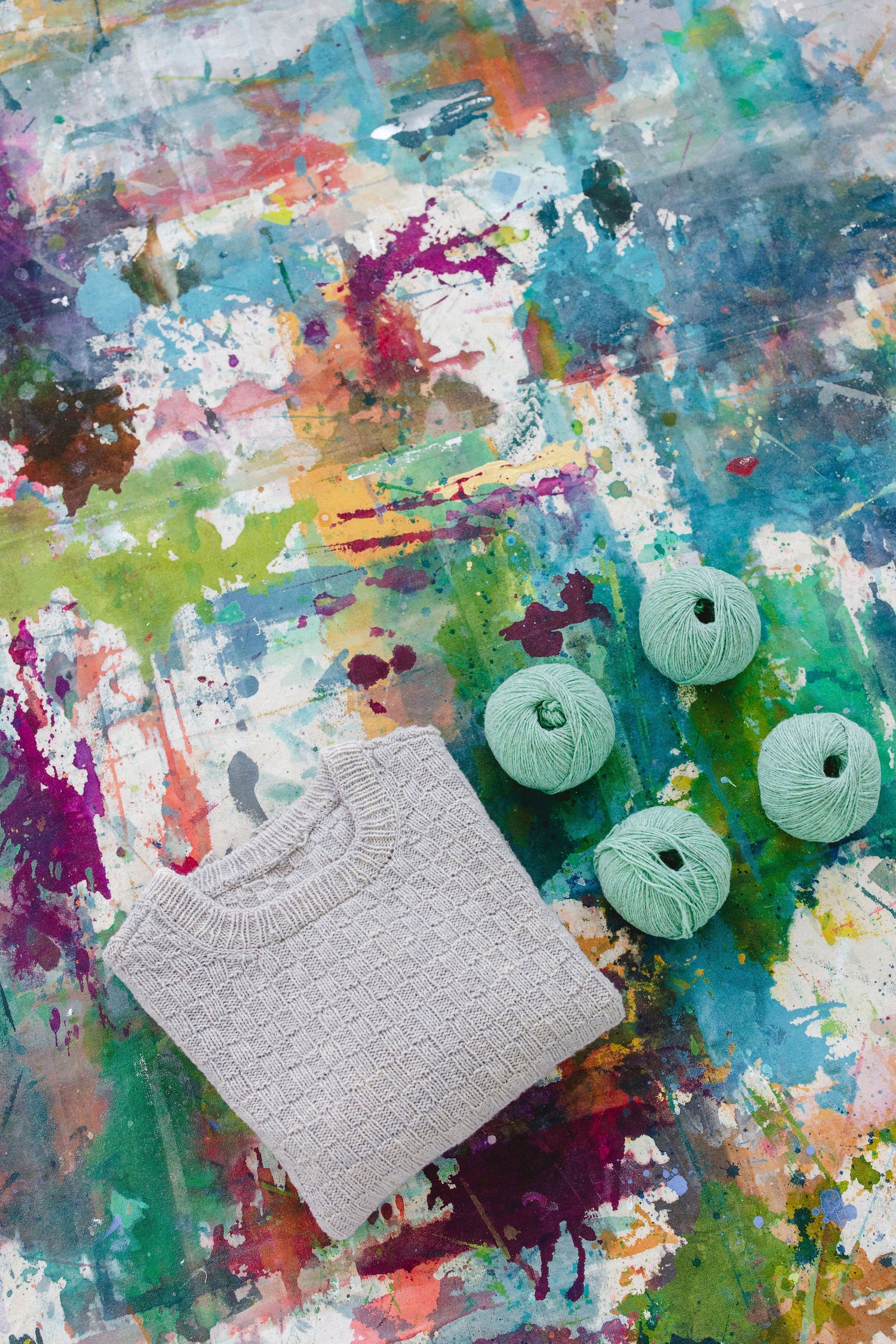
What's next for size inclusion in knitting?
We hope that many more designers and pattern sellers begin to create and advocate for a more size-inclusive knitting world, where all makers can access patterns that fit them beautifully.
It’s work we’re passionate about, and we continue to remind ourselves that the work is not done!
In the future, we are optimistic that we will continue to get improved resources for fitting bodies at the top of the size range. While we know that some charts extend past ours, much of that information is extrapolated and not based on large samples.
We think that the cutting edge of size inclusion probably lies in sizing guidance and changing industry standards about using full bust as the key fit measurement. Bodies of all sizes can have breasts of all sizes, and most makers will not get their best fit by using full bust as a guide.
We hope that you’ll chime in with your experiences! There’s no wrong way to love making your own clothes, and the community is richest with lots of different experiences, types of patterns, and resources. Send Jen a note, and let her know what you’re thinking!
If you found this article helpful...
If you found this article helpful, please consider visiting our Kofi page. Writing long-form content is something that is only possible because readers like you share our vision of a more inclusive future.
Whether it’s a one-time “tip” or joining us a monthly supporter, we appreciate your contributions and they allow us to continue to create paywall-free educational resources like this!
